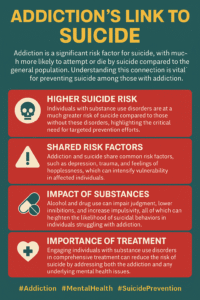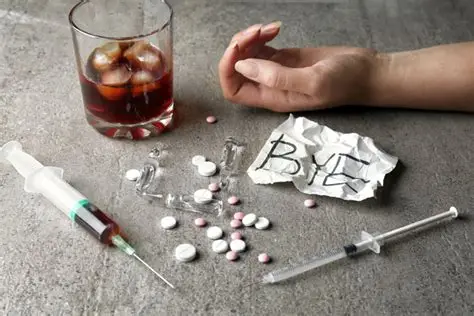Conversations around suicide prevention often go hand in hand with discussions about addiction. Both topics deal with struggles that can feel isolating, and both have connections that are a lot stronger than most people realize. Having spent some serious time researching and talking with professionals in this space, I’ve found that understanding this connection can really move the needle in getting people the support they need.
How Addiction and Suicide Are Linked
Addiction and suicide might feel like separate challenges, but there’s a lot of overlap. Studies have shown that people dealing with addiction, whether it’s alcohol, drugs, or even behavioral addictions, face a much higher risk for suicidal thoughts and behaviors than those who aren’t.
For example, according to the Substance Abuse and Mental Health Services Administration (SAMHSA), people with substance use disorders are at least twice as likely to think about suicide compared to the general population. This isn’t just a coincidence or a minor link. The reasons are pretty layered and include things like:
- Brain chemistry: Drugs and alcohol can alter mood and impulses, making someone more likely to act on dark thoughts.
- Stigma and isolation: Substance misuse often leads to shame or withdrawal from loved ones, increasing feelings of hopelessness.
- Co-occurring mental health issues: Many people with addiction also live with depression, anxiety, or other challenges that can feed into suicidal thinking.
Research shows that alcohol misuse by itself is responsible for countless cases of both accidental and intentional self-harm. People who regularly use substances often experience mood swings, lowered inhibitions, and altered judgment, which can make them more vulnerable during tough times. This is crucial for families, friends, and community members to recognize so they can jump in and provide meaningful support or guide someone toward professional resources.
Why These Connections Matter
Getting this link isn’t just for academic curiosity; it has real-life impacts. If you or someone you know is struggling with substance use, being aware of the heightened suicide risk means you know when to seek help or check in with others more closely.
It also helps break down some of those stubborn stigmas. When people realize addiction and suicide risk are often connected, it gets easier to talk about them openly and make space for honest support. This is important because silence or shame can keep folks from reaching out when needed. Resources like the National Suicide Prevention Lifeline (now 988 in the US) encourage everyone to see mental health as something worth talking about, no matter how tough things feel.
Communities, especially those with limited resources, often struggle under the weight of these topics. Public education and open, judgment-free conversations are changing that, helping to replace shame with compassion and promoting better outcomes for everyone involved.
Identifying Risk Factors
Knowing the risk factors can help spot trouble early. Most warning signs of suicide risk look similar for everyone, but there are a few that show up more often for people battling addiction:
- Loss of control: Feeling unable to stop using or increasing use beyond typical.
- Withdrawal from social circles: Skipping plans, dropping hobbies, or ghosting friends.
- Mood swings and irritability: Sometimes linked to either intoxication or withdrawal.
- Sudden calmness after a long struggle: This can sound positive, but sometimes signals a person has decided on suicide.
In my own conversations with mental health professionals, they always stress that while everyone can have bad days, a pattern of these signs deserves extra attention, especially if new stressors like job loss, relationship breakup, or health scares are added in.
It’s also worth looking out for signs of hopelessness, reckless behavior, giving away possessions, or feeling burdened. Each of these can be a red flag. When combined with substance misuse, these signs should prompt supportive friends, family, or caregivers to check in and encourage seeking help without making the person feel judged.
Barriers That Get in the Way
Unfortunately, several barriers make getting help for addiction and suicidal thoughts more complicated:
- Shame and stigma: Admitting to addiction or suicidal thinking can feel embarrassing or scary, so people might hide their struggles.
- Lack of access to care: Especially in rural or under-resourced areas, it’s not always easy to find mental health or addiction support.
- Financial stress: Treatment isn’t always cheap, and insurance doesn’t always cover everything.
Other barriers can include cultural misunderstandings, limited access to safe transportation, or a shortage of providers familiar with both addiction and suicide prevention. Fixing these roadblocks takes work from everyone: families, friends, health professionals, and policymakers. The good news is that changes are happening. New legislation, telehealth options, and peer support groups make treatment and support more accessible. For example, online chat and text support options (like those from organizations such as the Crisis Text Line) are helpful for people who are uncomfortable with phone calls or in-person visits.
What Suicide Prevention Looks Like in Addiction Recovery
Suicide prevention in the context of addiction focuses on both immediate safety and long-term healing. Here’s a closer look at the kinds of things I’ve seen experts recommend:
- Integrated care: The most successful programs don’t treat addiction and mental health struggles as separate issues. Instead, they create a plan that tackles both, with teams that include counselors, therapists, and medical professionals.
- Safety planning: These are practical steps created with a therapist or counselor to help someone stay safe during challenging moments. A safety plan might include a list of people to call, activities that help distract from intense thoughts, and ways to make the environment safer, like removing access to addictive substances or potentially harmful objects.
- Medication support: Medications can help balance brain chemistry, lower cravings, and manage related mental health issues. Programs like Medication Assisted Treatment (MAT) use science-backed methods for alcohol or opioid dependence.
- Peer and family support: Staying sober and safe is a team effort. Support groups and caring families can help on tough days and celebrate wins during recovery.
In addition, digital health tools like mobile apps for mood tracking, online therapy, and virtual support networks can play a huge role. These tools help people stay on track in their recovery, keep them connected, and offer guidance during moments of crisis.
Innovative Strategies for Getting Support
If you’re supporting someone facing both addiction and suicidal thoughts, there are a few things that make a real difference:
- Keep conversations open: Just having someone to listen, without judgment, can help someone feel seen, not alone.
- Get professional help early: Therapists and addiction specialists have training to spot risks and make recommendations long before a crisis occurs.
- Encourage healthy routines: Eating well, getting sleep, and staying active might sound simple, but they can help balance mood and reduce risk.
- Know the warning signs: Brush up on risk factors, and don’t ignore sudden changes in mood, sleeping, or habits.
If you’re unsure what to say, sometimes letting someone know you care and are ready to help is enough to prompt them to share more. For anyone needing immediate support, resources like Suicide & Crisis Lifeline (988 in the US), SAMHSA’s National Helpline, or local emergency lines are available around the clock.
Challenges in Addressing Both Issues Together
It’s totally understandable to wonder why it can be so tough to tackle addiction and suicide together. The short answer is that these are complex, personal struggles, and the best approaches recognize people as individuals, not just as statistics or symptoms.
Many people feel pressure from family or society, or wrestle with guilt and fear about asking for help. In my experience, chatting with those in recovery, the most meaningful progress often starts when those barriers start to come down. Real healing can begin when treatment feels welcoming and people stop feeling like they have to hide their pain.
Programs built to address both challenges are becoming more common, but finding a team that understands both addiction and suicide risk can still take persistence. Community groups, national organizations, and some religious institutions also offer supportive options, and it’s good to connect with multiple sources of encouragement and advice.
Hope and Healing: Real Stories Matter
Stories of recovery and support can light the way for others. I’ve watched people in recovery share tales of their lows and their healing steps. Peer-led groups, community organizations, and online forums offer places to swap these stories, so no one has to feel like they’re the only one going through it.
Those who have recovered often become strong advocates for their communities, supporting others, sharing their insights, and creating safe spaces that break the cycle of isolation. Hearing about someone who faced both addiction and thoughts of suicide, and gradually rebuilt their life, gives hope to everyone who’s still struggling and reminds us all that things really can improve.
Practical FAQ About Suicide and Addiction
Here are some questions people often ask when they’re trying to understand the connection between addiction and suicide better:
Question: Does addiction always lead to suicidal thoughts?
Answer: Not everyone with an addiction will feel suicidal, but the risk is much higher. If you or someone you care about is struggling, checking in with a mental health or addiction specialist is a good move.
Question: What’s the best way to help someone who’s talking about both their addiction and suicidal thoughts?
Answer: Encourage them to talk to a professional as soon as possible, offer to help find resources, and keep communication open. Even just listening can mean a lot.
Question: Are there specific therapies for people facing both challenges?
Answer: Yes. Integrated care, where a team treats both issues, shows better results than treating them separately. Some options include cognitive Behavioral Therapy (CBT), Dialectical Behavior Therapy (DBT), and Medication-Assisted Treatment.
Moving Forward and Finding Support
No one has to handle these challenges solo. The connection between suicide and addiction is something that people are talking about more and more, which helps break down barriers, remove stigma, and make support easier to find. If reading this raises personal worries, reaching out for help is always wise.
Recovery is possible, support is out there, and things can improve with time, honesty, and connection. I’ve seen this repeatedly, both in research and through honest conversations. Remember, supporting one another and staying informed can make all the difference, and taking a single step—like starting a conversation or calling a support line—might be life-changing for you or someone you care about.
Video: Can Addiction REALLY Lead To Suicide?

